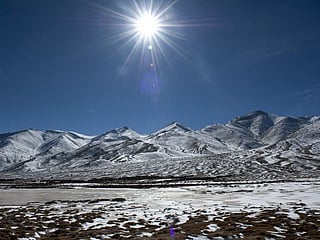Is US ceding space to China?
Beijing is spreading its economic muscle in the strategic Central Asian Republics

Also In This Package
In the midst of Covid-19 pandemic, there has been a war of words between the US and China. Many observers are paying close attention to renewed American interest in Central Asian Republics (CAR).
The area, formerly a part of the former Soviet Union, comprises of five countries Kazakastan, Uzbekistan, Turkmanistan, Tajikistan and Kyrgyzstan. Launching its new Central Asia strategy in February, the US Secretary of State Mike Pompeo visited the region in one of his only three trips abroad since the Covid-19 outbreak.
The abundance of hydrocarbons, its economic promise and its location bordering both China and Russia makes CAR a subject of international attention. As these states spun out of Soviet Union, Russia remains the dominant power in several facets of their lives.
In Kazakhstan alone, China has invested over $70 billion, mainly in oil sector, which is 80 per cent of investments made in the CAR. Turkmanistan, though not sharing border with China, is dependent on China for its gas production
During the last two decades China has developed strong energy and other economic interests, making stability in the region one of its primary concerns. Central Asia is a fundamental link in China’s economic and strategic reach across the Eurasian land mass.
China's backyard
The region, critical to both, is Russia’s underbelly and China’s backyard. The US earlier used the CAR as an alternate freight route to Afghanistan when access through Pakistan got disrupted. Both China and Russia, deeply entrenched in the region are unlikely to cede space.
Since beginning official links with the CAR in 1991 China is already its largest trading partner and investor. China needs energy, minerals and raw material from the region.
In Kazakhstan alone, China has invested over $70 billion, mainly in oil sector, which is 80 per cent of investments made in the CAR. Turkmanistan, though not sharing border with China, is dependent on China for sits gas production. It exports mainly to China.
In addition to the energy supplies and market for the Chinese manufactured goods, CAR is critical to China’s reach towards Europe through the BRI projects.
Investing in economic growth in the neighbouring CAR along with economic transformation of its own western province of Xinjiang, which shares ethnic, cultural and religious links with the CAR, appears to be China’s goal to bring stability to its own western region.
China is sometimes the only source of prosperity in the impoverished region. The volume of Beijing’s economic engagement, ensuring favourable conditions for itself, do translate into political and security influence.
China nonetheless, shows no ambition to remake local politics in the CAR.
Quality of projects
Deals struck in the region are sometimes are not always to easy to explain. There is a grudging praise however, for the extent and quality of projects undertaken with Chinese assistance that provide jobs and benefits to the local populations.
Much of the pockets of affluence in these countries, come alongside Chinese funded projects or Chinese businesses.
While China spreads its economic influence, Russia’s influence over the CAR as a security provider — a throwback to the Soviet era, remains. Such a position shields threats to the Russian territory and also works as a control mechanism over the former Soviet republics. Garnering support in the region is therefore, a tough mission for the US.
Remaining passive in the region for many years, the US now seems to realise that unless it becomes more active in the wake of impending exit from Afghanistan, it will have a little stake left in a strategic region.
Except for possible counterterrorism cooperation, if necessary, there is little on which US, Russia and China agree. The US attempt is therefore, a zero-sum game in competition with entrenched players, Russia and China, which the US has little chance of winning.
Officials visits to CAR, especially during the Trump era, tends to be heavy on aggressive warnings and light on promises. Offering a $1 million for technical assistance to Uzbekistan dwarfs the enormous size of Chinese commitments, for instance.
Secretary Pompeo (on a first cabinet level mission from US to the region in half a decade), was keen to warn the regional states of cooperation with China but suggested no realistic alternatives.
Clearly referring to American attempts to play its big power game against China and Russia, the foreign minister of Uzbekistan said, “we would really not like to feel on ourselves unfavourable political consequences in relation to some competition in our region between large powers.”
The US has little chance of making its presence felt in the CAR.
A new “great game” is now underway in the region with leaders hedging their bets when it comes to aligning with Beijing or Washington.
The recently released “United States Strategic Approach to The Peoples’s Republic of China” underscores American paranoic assumptions based on China’s rise. The paper is a declaration of a new “Cold War,” which the US is unlikely to win. Perhaps the time for passing the baton has come.
Sajjad Ashraf was an adjunct professor at the Lee Kuan Yew School of Public Policy, National University of Singapore from 2009 to 2017. He was a member of Pakistan Foreign Service from 1973 to 2008 and served as Pakistan’s Consul General to Dubai during the mid 1990s.
Sign up for the Daily Briefing
Get the latest news and updates straight to your inbox









